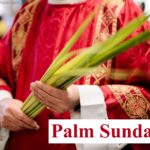
Throughout Holy Week, the final week of Lent, Catholics pray and reflect on the events leading up to and during the Passion, Death, and Resurrection of Jesus.
The holiest week of the year begins on Palm Sunday, one week before Easter Sunday. Palm Sunday is also called Passion Sunday.
On Palm Sunday, the liturgy focuses on both the joyful and sorrowful aspects of Jesus Paschal Mystery.
Solemn processions and the blessing and distribution of palm branches call to mind Jesus responding the the people crying out for help as he makes his triumphant entry ino Jerusalem where He will make his sacrifice.
The readings at Mass include a Passion narrative from one of the Gospels which recount Jesus’ inauguration of a new Passover which ends with his suffering and death on the Cross. Catholics participate in the readings out loud as a reminder that Jesus’ passion and death is the price that He paid for their sins.
A week set apart:
The holiest time of the year:
A journey from false triumph to true triumph:
All of Jesus’ emotions as He prepared for His struggle:
How will Jerusalem welcome her Messiah? Although Jesus had always refused popular attempts to make Him king, He chooses the time and prepares the details for his messianic entry into the city of “his father David”. Acclaimed as Son of David, as the One who brings salvation (Hosanna means “Save!” or “Give salvation!”), the “King of glory” enters his City “riding on an ass”. Jesus conquers the Daughter of Zion, a figure of his Church, neither by ruse nor by violence, but by the humility that bears witness to the truth. And so the subjects of his kingdom on that day are children and God’s poor, who acclaim Him as had the angels when they announced him to the shepherds. Their acclamation, “Blessed be He who comes in the name of the Lord”, is taken up by the Church in the “Sanctus” of the Eucharistic liturgy that introduces the memorial of the Lord’s Passover.
Catechism of the Catholic Church 559
Celebrating Palm Sunday around the world:
So they brought the colt to Jesus and put their cloaks over it. And he sat on it. Many people spread their cloaks on the road, and others spread leafy branches that they had cut from the fields. Those preceding Him as well as those following kept crying out: “Hosanna! Blessed is he who comes in the name of the Lord! Blessed is the kingdom of our father David that is to come! Hosanna in the highest!”
Mark 11: 7-10
A sign of victory for a humble King:
God responds to our cry for help:
Welcoming the King and Messiah with branches and shouting:
This is the first liturgical phase of this Sunday; symbolized by the palms, by the procession, by the joy that pervades it, with a note of mysticism, spread from east to west. In the second part is the Holy Mass characterized by the reading, just heard, of the Passion of the Lord. Unlike the first, it is marked by sadness, by a deep sense of emotion and tragedy. The liturgy suddenly becomes sad and grave: and the Cross, which in these days has been covered – and will still be, after this ceremony, to make us think of the mystery expressed by such a lofty emblem of pain and redemption – , the Cross, here it is: in front of us. It is visible; it is offered to everyone, because we all have to fix our thoughts, feelings, souls on the solemn, painful, pious and moving memory of the death of Our Lord Jesus Christ.
Pope Paul VI, Palm Sunday Homily, 11 April 1965
Jesus’ words and actions at the climax of his life:
Jesus’s love persisted through betrayal and crucifixion:
The readings for Palm Sunday are long for a reason:
The Truth, Goodness, and Beauty of the Catholic Church
Where economic resources are scarce but the people are rich in faith:
Share this page with friends and family to start a conversation about your faith.
Don’t miss a post. Learn more about the Catholic Church and strengthen your Catholic faith.
Find more Fiercely Catholic video issues here.
Subscribe here.


